This bucket list item was completed on 26th August 2024 in Shark Reef, Pacific Harbour, Fiji.
Between 2010 and 2020, I managed to complete at least one item from my bucket list each year, but often many. Then someone ate some medium-rare bat meat and the whole world shut down, and so did my bucket listing. The last item I completed in 2020 was #98 Go BASE Jumping. Little did I know that this was going to spark a passion like I have never had for another activity. So, while the world was shut down, I chose more adventures within New Zealand and prioritised BASE jumping as much as I could.
Also, in the years between 2020-2024 I found myself on a couple big, multi-year projects, which kept me busy. But work isn’t fun, travelling the world and chasing adventures is fun. After a hard month of commissioning a geothermal pipeline, I decided that I needed to renew the bucket list activities in my life. The obvious choice… flying to Fiji and swimming with sharks. It’s a short flight from New Zealand and a favourite spot for Kiwis trying to escape the winter blues.
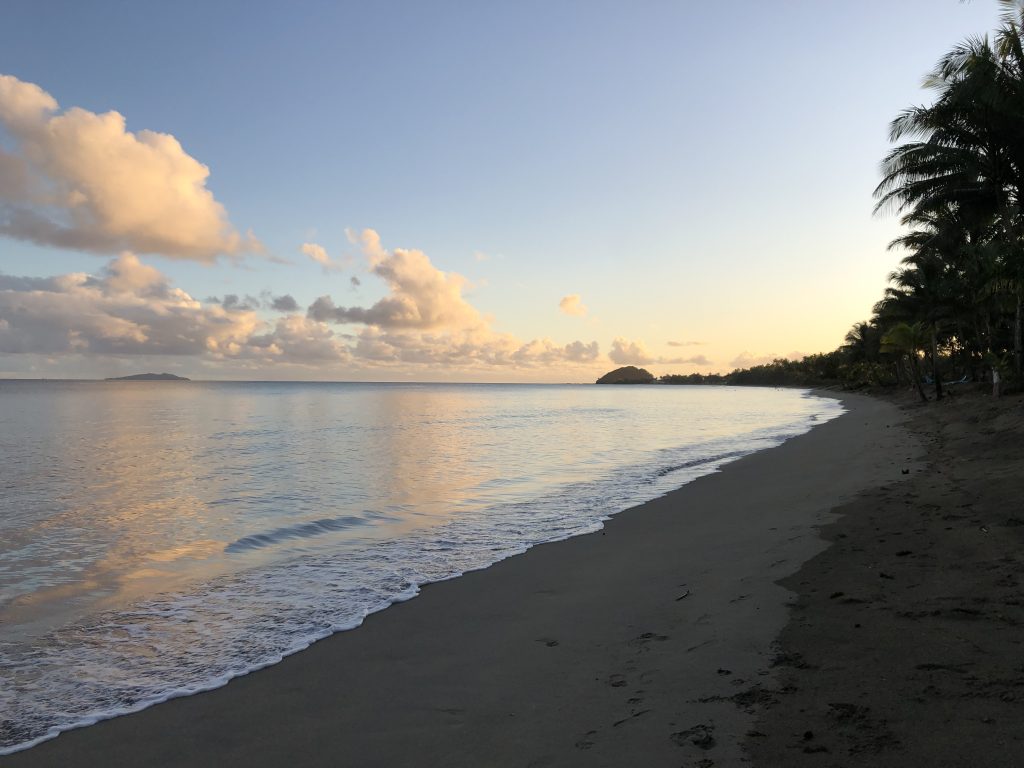
I had known about the Beqa Lagoon for several years and had heard of “The Shark Dive” from my previous trip to Fiji in 2015. I had planned to come in 2020, when I was supposed to join a bunch of friends for a surf trip on the Coral Coast, just a short drive from Pacific Harbour. While that didn’t happen, I never lost sight of this being the location that I would cross this item off the list. Once I decided this was going to happen, I went through the motions of booking the flights, hotel, car rentals and a weeks’ worth of diving with Beqa Adventure Divers. Boom! Trip planned in record time.
I caught an early flight out of Auckland and landed in Fiji around 10 am on the Saturday. After half a dozen “Bulas” and some confusion of where to meet my rental car pick up, I found my driver. He took me back to the rental car shop, in the already sweltering heat. I was presented with the most basic model of the Toyota Vitz, which is about as basic as it comes for any car.
The rear view mirror bounced around all over the place, the front right tyre rubbed on the guards when you turned left and a Japanese lady shouted something at me, through the radio, every time I turned on the car. Oh well, this was all I need to get me from A to B. At least the A/C was icy cold.
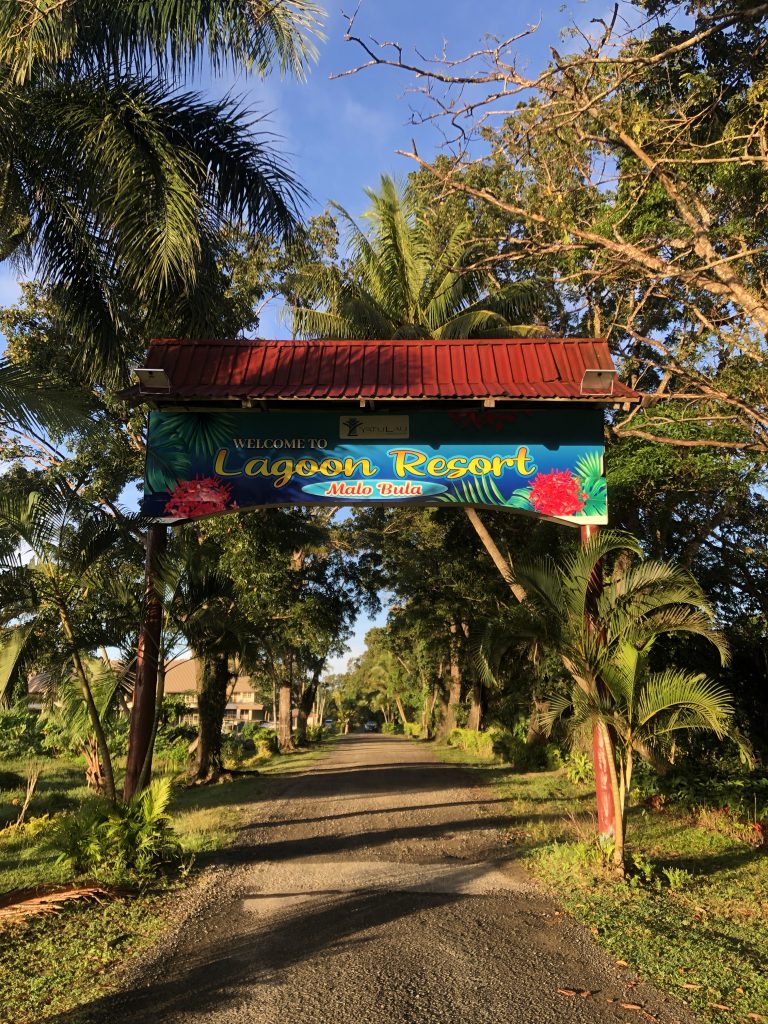
I arrived at the Yatu Lau Lagoon Resort later that afternoon and checked in to my room. I conveniently booked into the resort right next to the dive shop to make my life easy. After unpacking and getting my life sorted, I headed over to Beqa Adventure Divers to get setup and ready for the next day.
On Sunday we went out on a morning coral reef dive because The Shark Dive wasn’t operating that day. I planned it this way too, so that I had a couple tune up dives before The Shark Dive on Monday. Turned out that Sunday was by far the roughest seas that I saw while I was there. It was sunny, but with howling winds and 2 m swells. The boat was pounding through the waves to get us to and from the dive sites and at one point I went completely airborne out of my seat. The visibility wasn’t great, but we still saw a turtle and a small reef shark.



The next morning, I was amped for The Shark Dive. I returned to the dive shop, checked in and was directed to my boat. The boat was named Predator and at the helm was Captain Joe. He is a legend of a captain and got us through Sunday, so I was glad to be with him again. The trip from the dive shop, out through the estuary, is always calm.
The divemasters gave us the briefing of The Shark Dive as we were making our way through the estuary, because sure enough, once we hit the open ocean, the waves started rocking the boat around. There was not as much swell as Sunday, but still a bit hanging around from a storm that passed through overnight. Joe did his thing and got us out to Shark Reef safely.
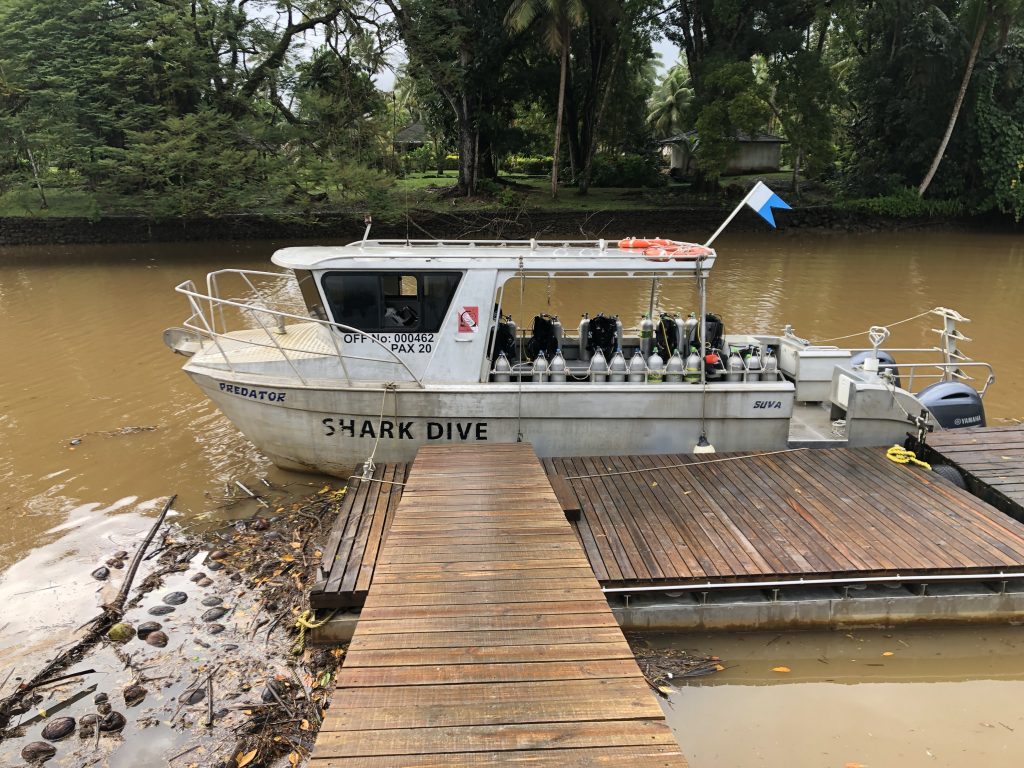

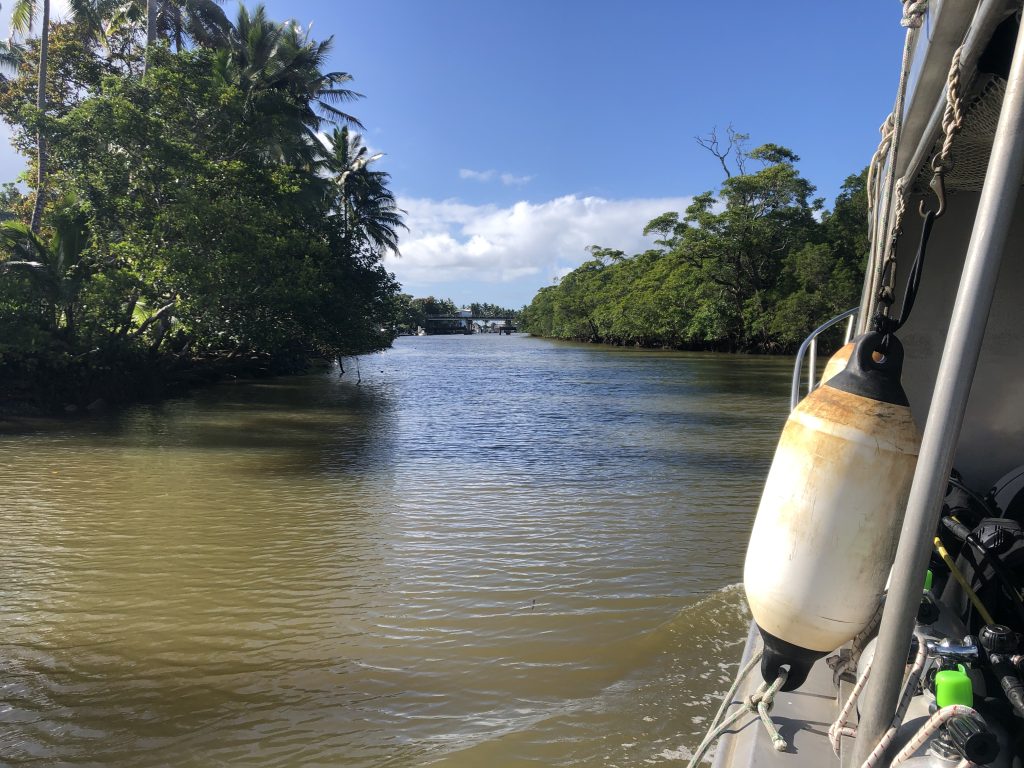
Dive 1
The briefing for the first dive had us descending to a coral wall at the edge of The Arena, sitting in 30 m of water. Our time at The Arena would last 15 minutes, then we would move up to the next ledge, directly above The Arena, at 10 m deep, for another 15 minutes. Then we would make our way up to the last ledge, at 5 m deep, for another 10 minutes.
As expected, there were some pretty strict rules about using selfie sticks while on the dive. Cameras could be taken, but they had to be held close to the chest, and only on short mounts, that could not extend. I asked in advance regarding cameras, and they told me that they had a videographer on each dive, so I chose to take it all in with my eyes and buy their footage later. Other safety items included the mandatory wearing of gloves, staying close to the coral while ascending/descending and minimising splashing and panicking on the surface.
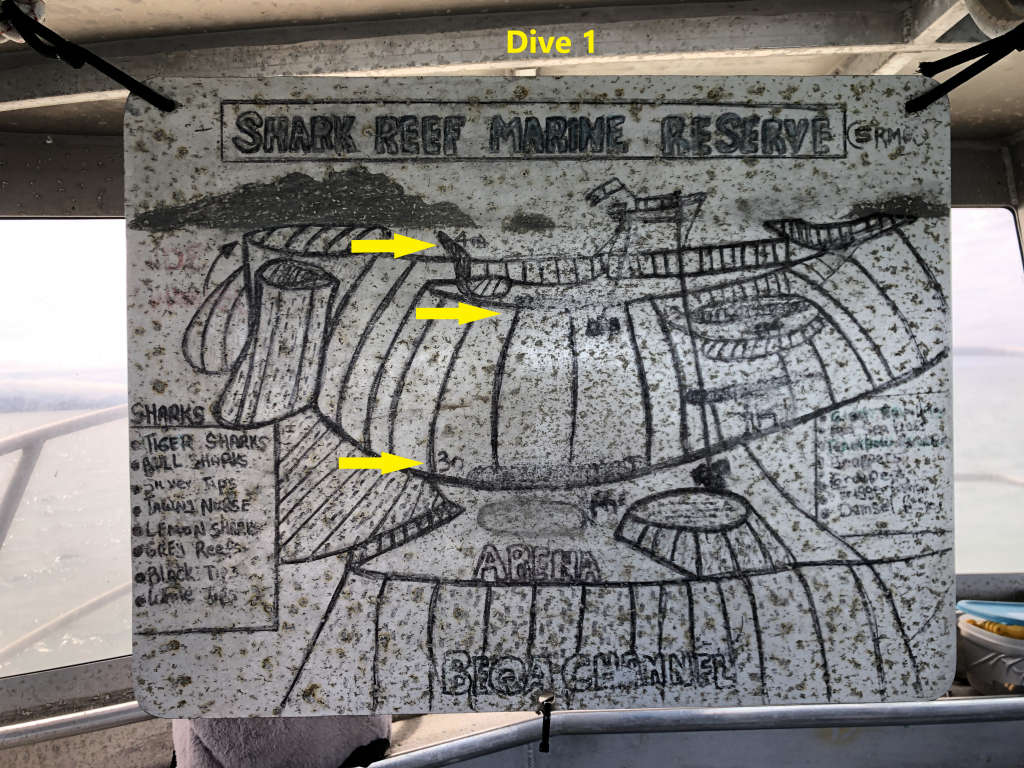
With the briefing complete, Captain Joe moored us over the reef, and we hit the water. I was one of the last ones in the water, so shortly after I jumped in, we descended. We followed the coral down to the wall that sat at the edge of The Arena, staring out into the blue. I perched myself with my knees on a paving stone, that they had placed at the bottom, and my arms resting on the coral wall.
As soon as we got down, the action started! One of the divemasters was hovering out in front of us with a steel box connected to long chains. The box was full of tuna heads, a favourite of the sharks. By having it connected to a long line, the divemaster could tilt it and dump out one or two tuna heads at a time, while keeping himself a safe distance from the sharp teeth going after the food.
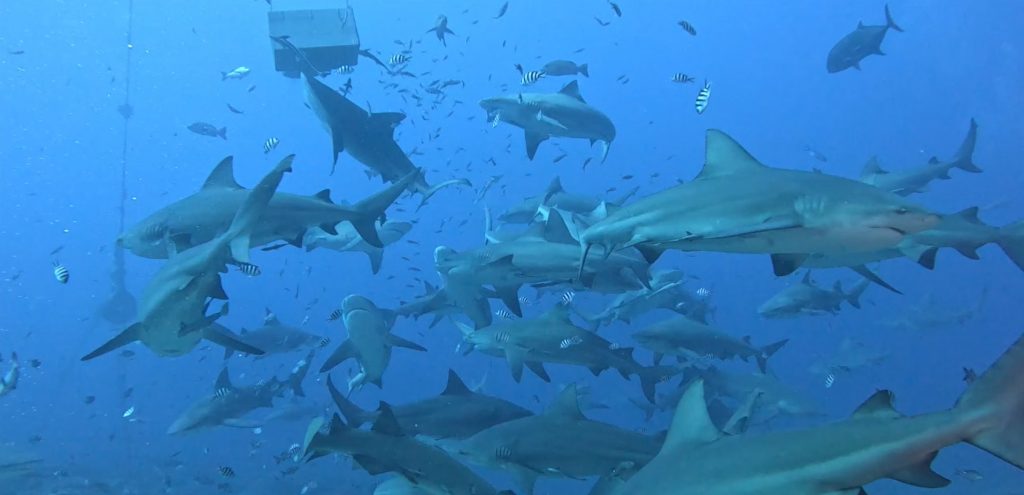

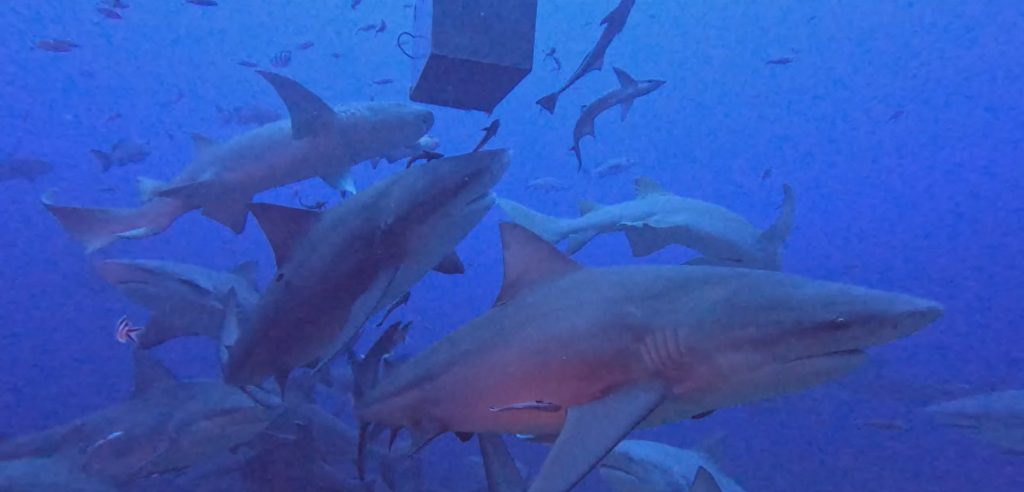
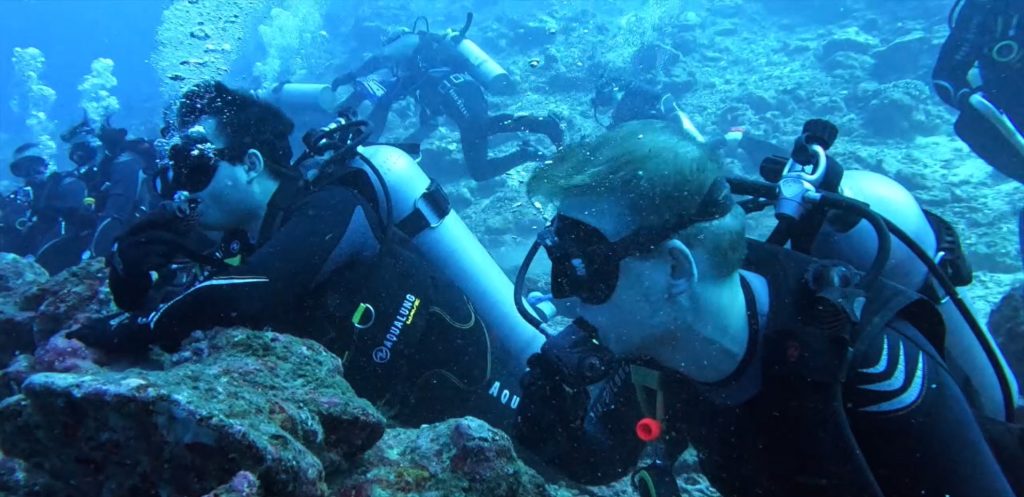

The box of food always stayed about 10 m away from us and about 2 m above us, but he swam up and down the line of us sitting on the coral wall. As he moved, the shiver of sharks moved with him. They knew the routine and followed the box for their chance to get one of the delicious heads. While the box stayed a safe distance from us, the sharks moved all around it.
At times, they would glide past you within a couple of metres, their eyes locking with yours as they inspected you on their way past. They know who we are and what’s going on, and they would often swim down the line to get a feel for our temperament.
The shiver of sharks numbered more than 40, which was mostly made up of female Bull Sharks. The females grow bigger than the males and they are the top of the pecking order at Shark Reef. They are the ones hanging around the box and when a tuna head is released, they open their jaws to an amazing size and swallow the heads whole.
With their snack in their mouth, they dart away into the blue water and chomp a couple times to moved it back into their bellies. As they do this, you can see the blood flushing out through their gills. At that depth, colour is distorted, and the blood looks green as it trails down past their bodies while they swim away. This surprised me, because I had never seen blood at that depth before.
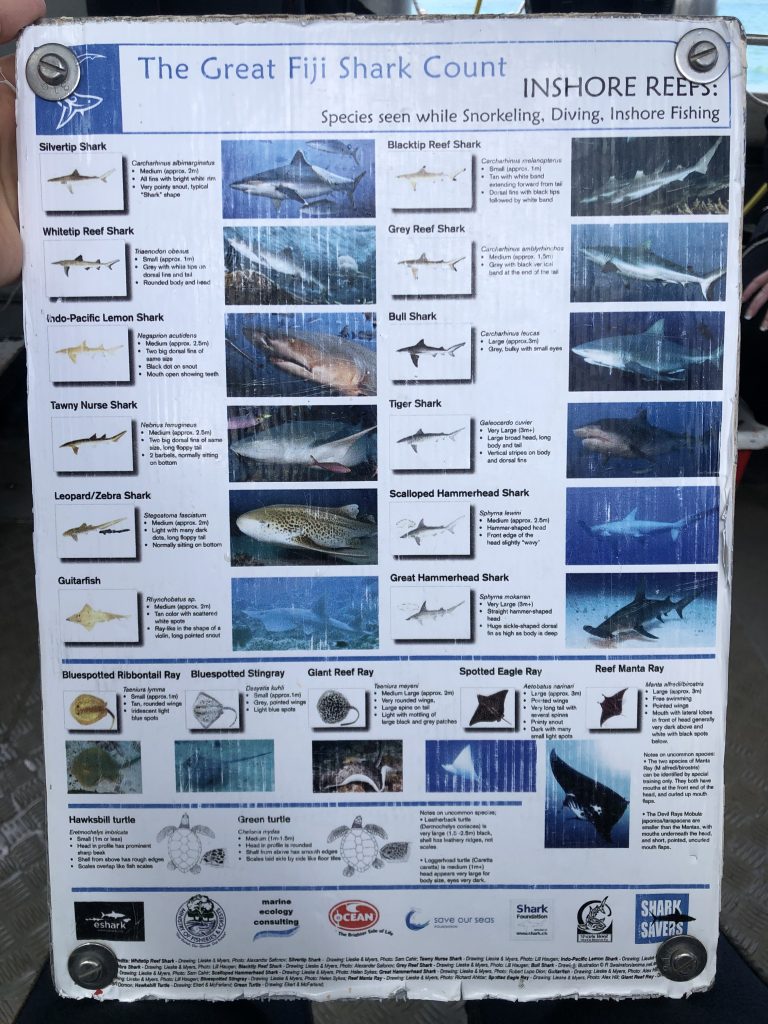
Next in the order would be the male Bull Sharks, then the Tawny Nurse Sharks, which were mostly all males and there was about 6-7 of them hanging around. The Tawny Nurse Shark is a bottom feeding shark, which is used to breaking shellfish with their jaws and sucking the meat out of the shells. They can even suck a giant clam out from its shell. However, tuna heads are a challenge for them.
They have tiny mouths, so they can’t swallow the heads in one bite. Instead, if they are lucky enough to get one, they clench it in their teeth and swim to a nearby bit of rock or coral, where they start smashing it to break it up. As you can imagine, when one Tawny does this, they all notice, then it gets a bit chaotic. Every Tawny rushes in for their share, but so do all the parrotfish, giant trevally, and any other reef fish hanging around. This creates a mad frenzy for a minute or so, before all the bits have been devoured.

The lowest of the pecking are the Giant Grouper (Hapuka in New Zealand), though not by much. There are two that hang around, Mini Ratu (the big one) and Micro Mini Ratu (the small one). Ratu means chief in Fijian, so the first time that the big one showed up, they called him “mini chief”. A few years later, the smaller one showed up and they realised the error of their naming convention. Hence why the small one got micro mini.
They are lowest on the pecking order and literally hang out the lowest as well. They don’t have razor sharp teeth, but they are more cunning than the sharks. They followed directly below the steel box, hanging just at the edge of the shiver, with their bodies angled at 45°, watching everything.
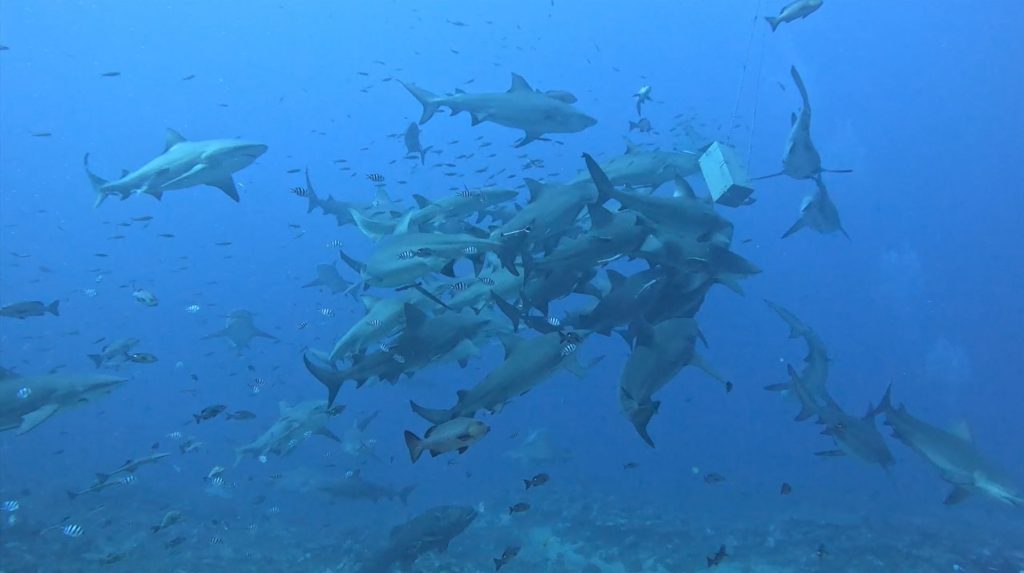
When the Bull Sharks come for these tuna heads, they are not in “hunting mode”. It’s an easy feed, so they are much more relaxed, compared to when they are out hunting real prey. As such, they often miss a tuna head if a few come out of the box at once. If you focus on the tuna head, you can watch it sink straight down, while a tornado of sharks circle around it. But you know who else is focusing on this sinking tuna head? Mini Ratu.
As the head nears the bottom of the tornado, Mini Ratu strikes! He is lightning fast, hitting it perfectly, opening his jaws to be as big as the Bull Sharks around him. In one bite, it’s gone! As he starts his strike, the sharks notice, but it is too late. By the time they get there, it’s already in his mouth, but this pisses them off.
I witnessed a couple of them give him a nudge after stealing their treat, but he’s a big boy and slaps two or three of them in the snout before retreating to the bottom. He knows his place, but he knows how to get a feed as well. Micro Min Ratu is still learning how to perfect this technique.
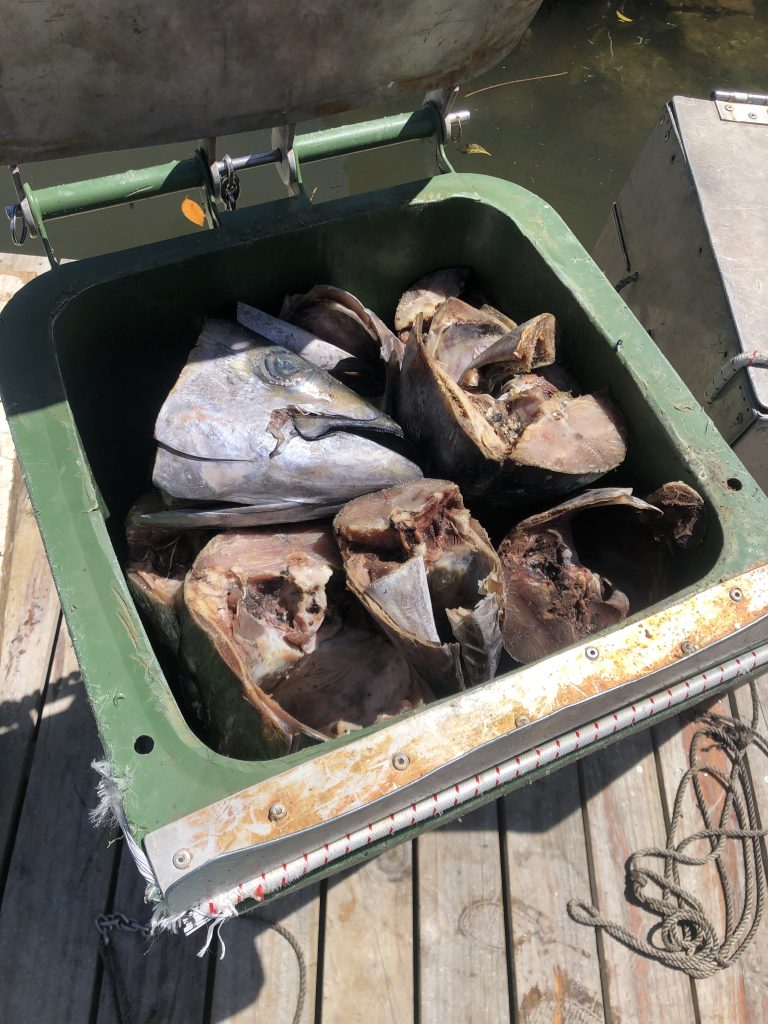
At the 15 minute mark, the divemasters bang on their tanks to signal that it is time to move up to 10 m. There is a coral ledge at this point with a fixed steel box filled with smaller bits of tuna. Instead of facing out into the blue, we rest up against the coral wall, facing in toward the ledge. With a different level in the ocean comes a different hierarchy of sharks. The Bull Sharks don’t follow us up, they stay down in The Arena or take off to go hunting. This level belongs to the Indo-Pacific Lemon Shark and the Grey Reef Shark. The Lemon Sharks are slightly smaller than the Bull Sharks and the Grey Reef Sharks are smaller again.

With their smaller size, and different personality, it is safe for the divemasters to hand feed the sharks. Two divemasters work as a team to operate the feeding. One kneels in front of the box and hands out the food, while the other stands over him with his trident-like pole and keeps the sharks at a safe distance, until he is ready to offer up a piece of tuna. This is a much more intimate exchange between humans and sharks, so the divemasters must be careful.
They are constantly watching as the sharks enter their space, looking for food. While they are doing this, the other six divemasters are back-to-back with us and scanning the blue to see what sharks are lurking out there. Should the sharks come close, they would use their poles to gently redirect them. It is all very coordinated, after completing hundreds of these dives as a team.
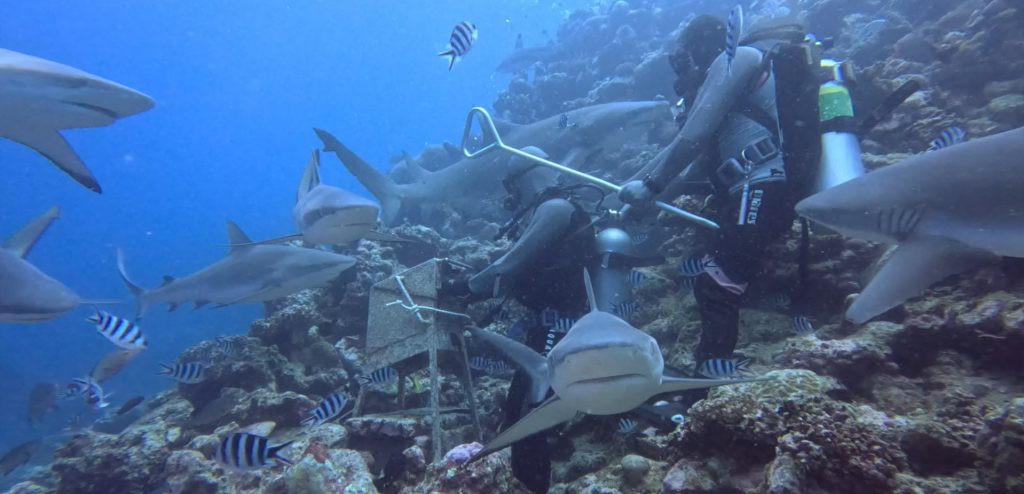
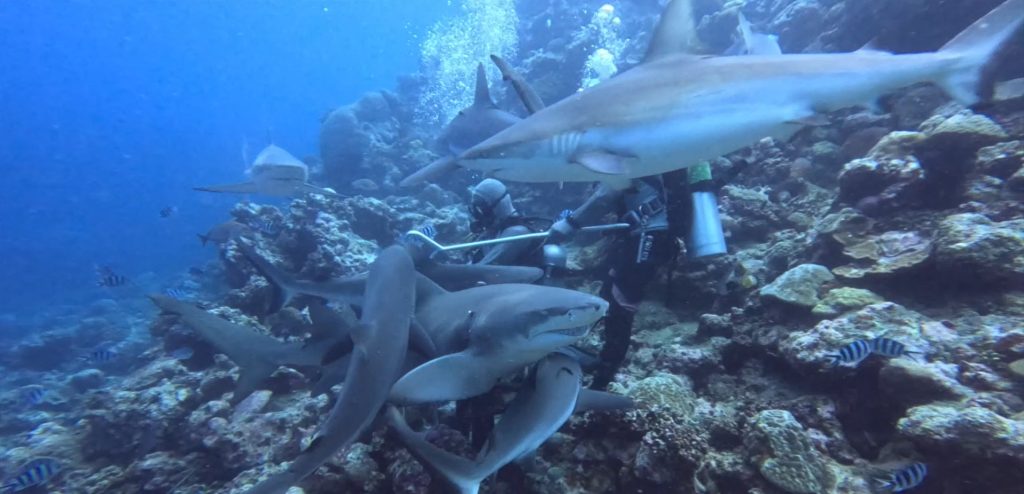
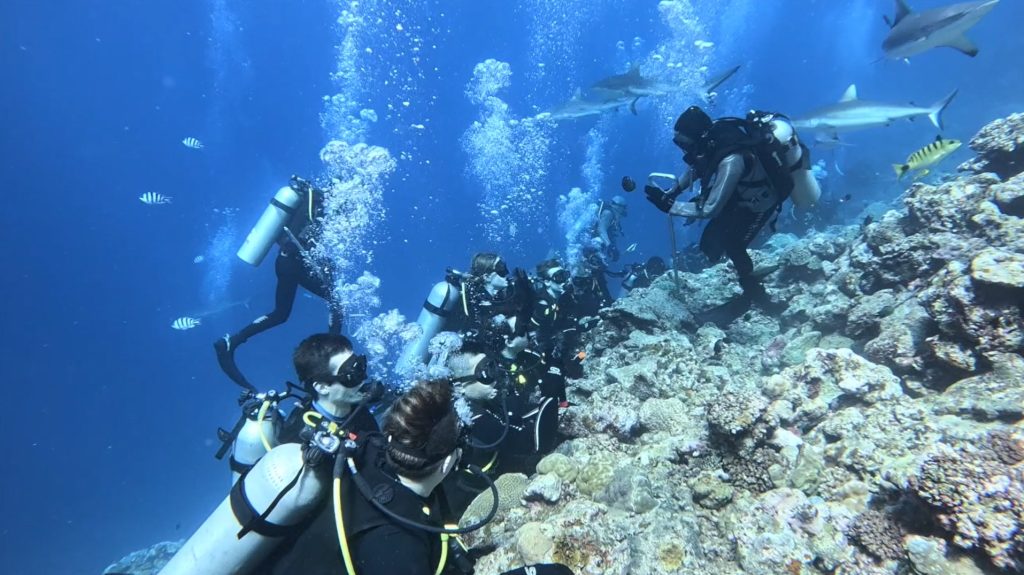
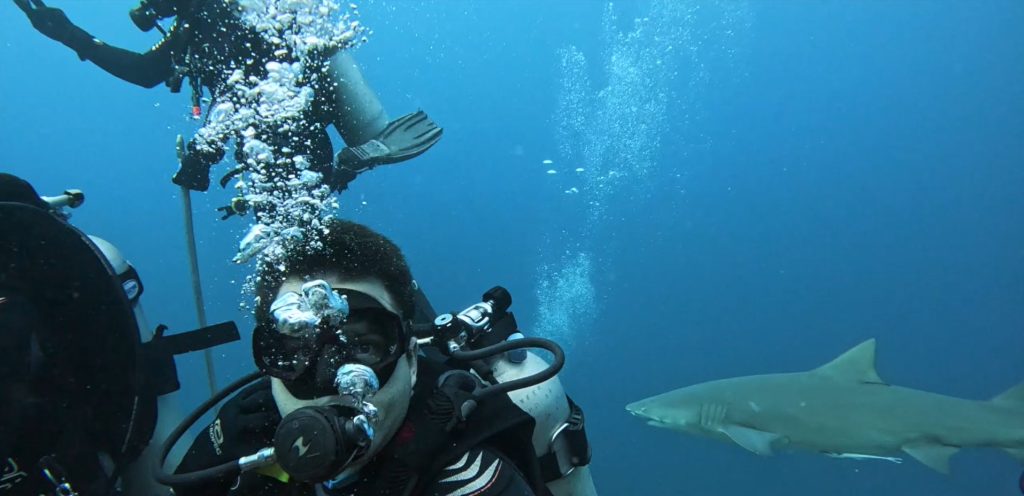
So, let’s talk about personalities, because if you think a shark is a shark is a shark, you’re wrong. The Bull Sharks are the biggest on the reef, so they lead with confidence, but they don’t like getting close to us unless they must. They appreciate their own personal space and will cruise by to look at you but avoid touching you if they can. They all have names too: Top Sail, Batman, Big Poppa and Talisi are a few. The Tawny Nurse Sharks are essentially fluffy dogs that like belly rubs.
Sometimes the Nurse Sharks will come up to the 10 m ledge to get some hand feeding. On more than one occasion, I witnessed one of them roll on its side and rub its nose against the shin of the divemaster hand feeding. Picture a Labrador when you take anything out of the fridge, giving you those starvation eyes. Sashimi and Chop Suey were the most identifiable ones from their damaged pectoral fins.
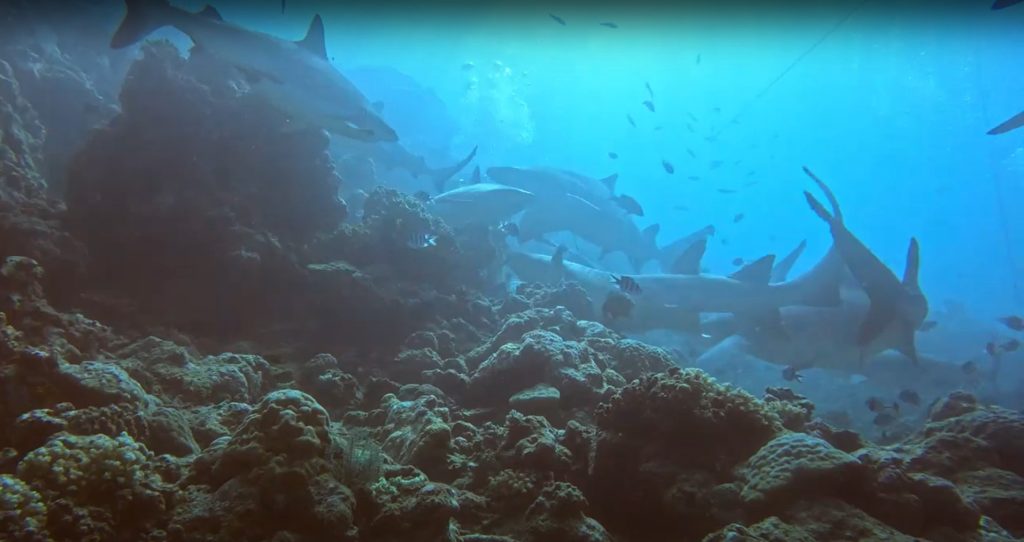

The Lemon Sharks are pretty chill and like cruising around, but they also have no awareness of personal space. When they see food, they take a direct path, which often means bumping into other sharks, the divemasters, or one of us. They don’t really care what they touch, they’re just looking for a morning snack, but with names like Tootsie and Sprinkles, you let them get away with it.
The Grey Reef Sharks are smaller and tend to stay clear of everything, and only come close to get some food. These sharks were slow to accepting hand feeding because of their timid nature, and you can still see it as they come in for a feed then get out of there as quick as they came.
After another 15 minutes we moved up to another ledge at 5 m, facing into the reef and holding on to a rope, strung across the coral reef. A carefully positioned PVC tube of tuna pieces awaited a lone divemaster. This was also positioned outside of the home of a large moray eel who came out to check us out while we were hanging around. The divemaster held the tube between his legs, unscrewed the cap and pulled out small pieces. These smallest pieces were being fed to the smallest sharks on the reef, the Blacktip Reef Sharks.
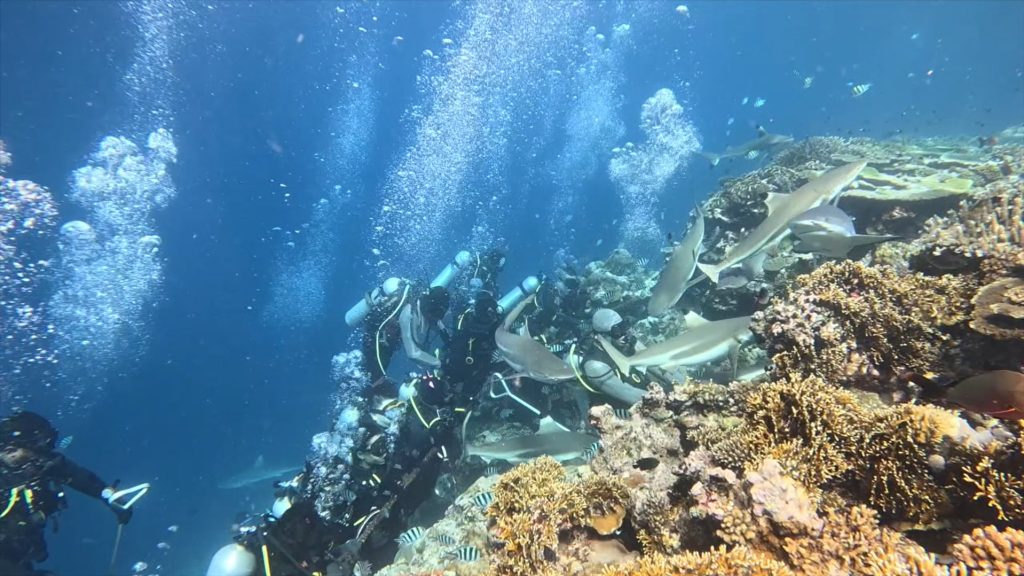
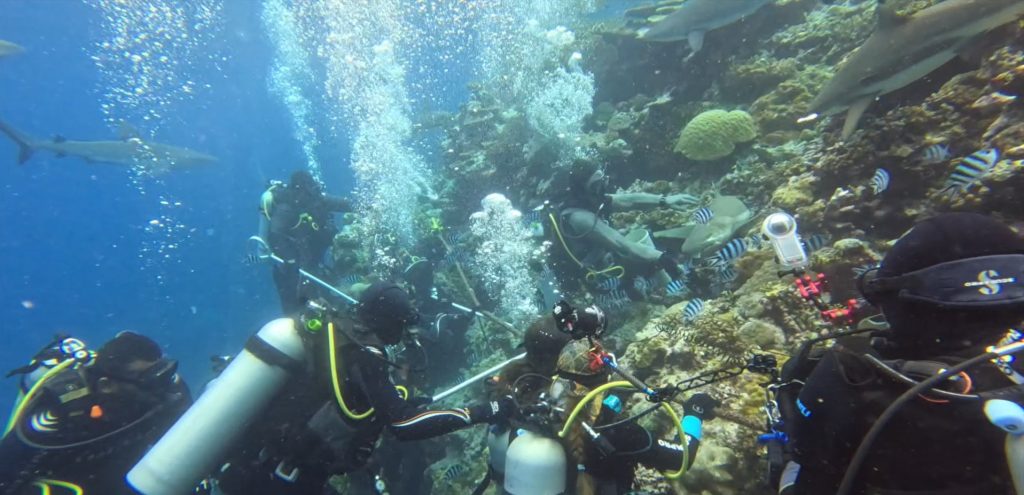
If Bull Sharks are the big dogs, Nurse Sharks are Labradors, then the Black Tips are those little yappy dogs, that act tough but then run away. Their personality is exceptionally wiry, as they dart around the tops of the reef. They’re skittish little creatures, who pop in for a quick look and then take off. If they take a piece of tuna, they fly out of sight as quick as they can, but then they’re right back a few seconds later.
None of the other sharks come up to this level, so they have no rivals, but there are 15 of them looking to cash in a on a little snack. Their nervous and shy nature has meant that they adjusted slowly to humans. It took the divemasters 3.5 years for the Black Tips to start accepting food. Even now, they still appear shy.
After a one-hour surface interval, filled with tea and cookies, we were ready for our second dive. Thanks to Captain Joe, Pate, Si, Sydney, Earl, Malo and the rest of the crew for the amazing hospitality onboard.
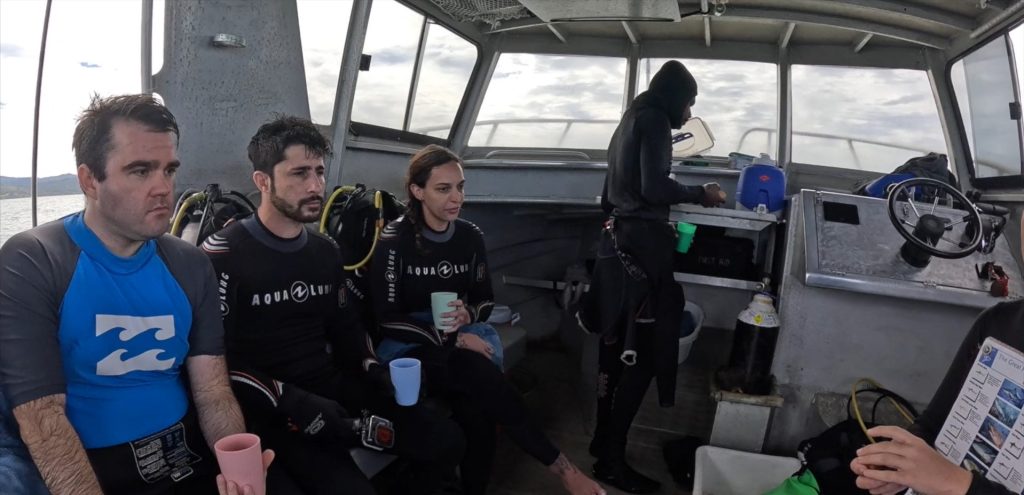

Dive 2
I questioned how different they could make the second dive, but this is not their first rodeo, and they were quick to diminish my scepticism. The briefing for the second dive had us descending to a small coral wall, at 25 m depth and slightly to the right of The Arena. This wall was small enough that we were instructed to lay flat on the sea floor and watch the action. Also, they promised that the action would come closer to us.
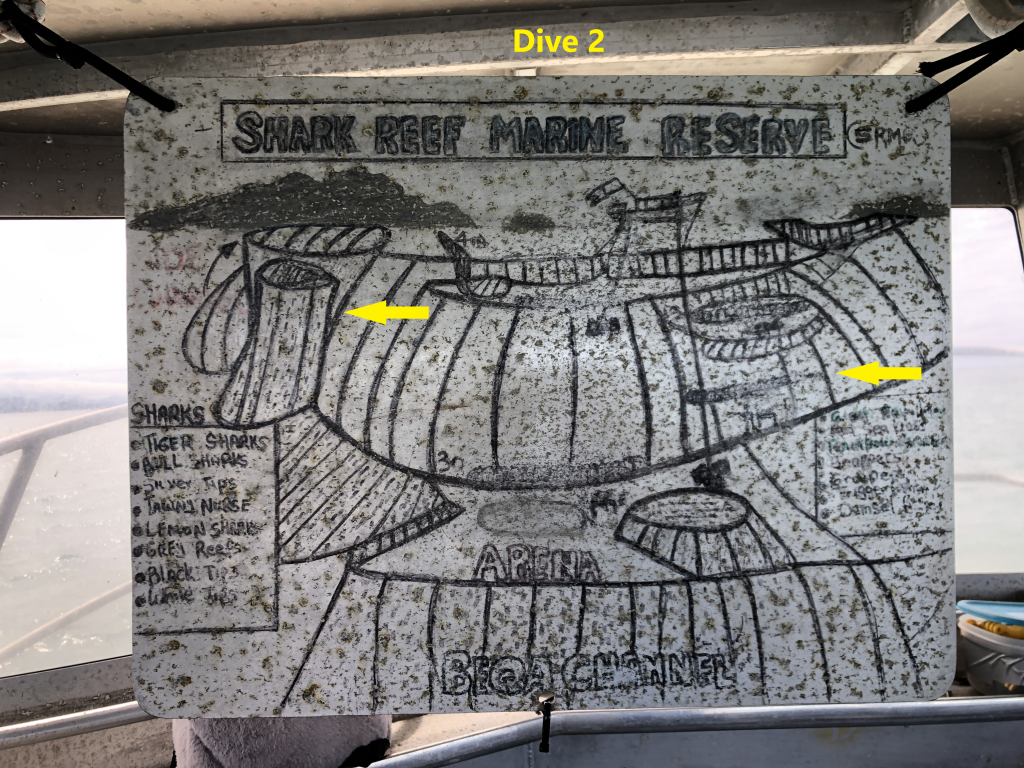
We descended from the same location on the surface and made our way to the small wall at 25 m. As we stacked into position on the wall, I could see the divemaster arrive with a green wheelie bin, rigged up in the same manner as the steel box, with long chains. It was slightly larger than the steel box, which meant more tuna for the sharks. Watching the divemaster manipulate the bin to only release 1-2 tuna heads at a time as he moved up and down the line was impressive: an artform. And as promised, the action got closer… Way closer!
On this dive, the wheelie was only a couple metres up and out from our heads. That meant the tornado of sharks was almost directly upon us. From this close you could make out fine details of their eyes, scars on their bodies or irregularities in their skin. Their skin is what fascinated me the most. I couldn’t stop looking at it! The texture, colour and everything about it is the result of millions of years of evolution, and it is amazing to see from inches away.
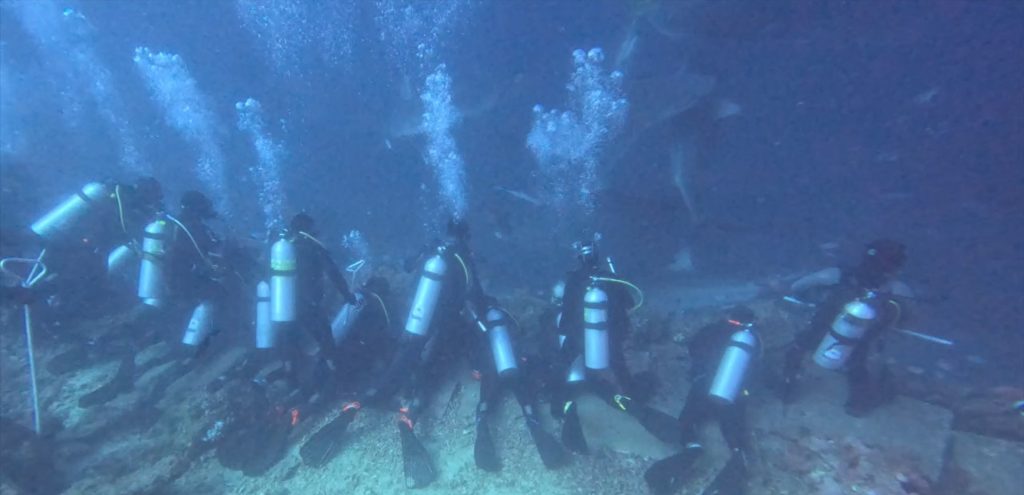
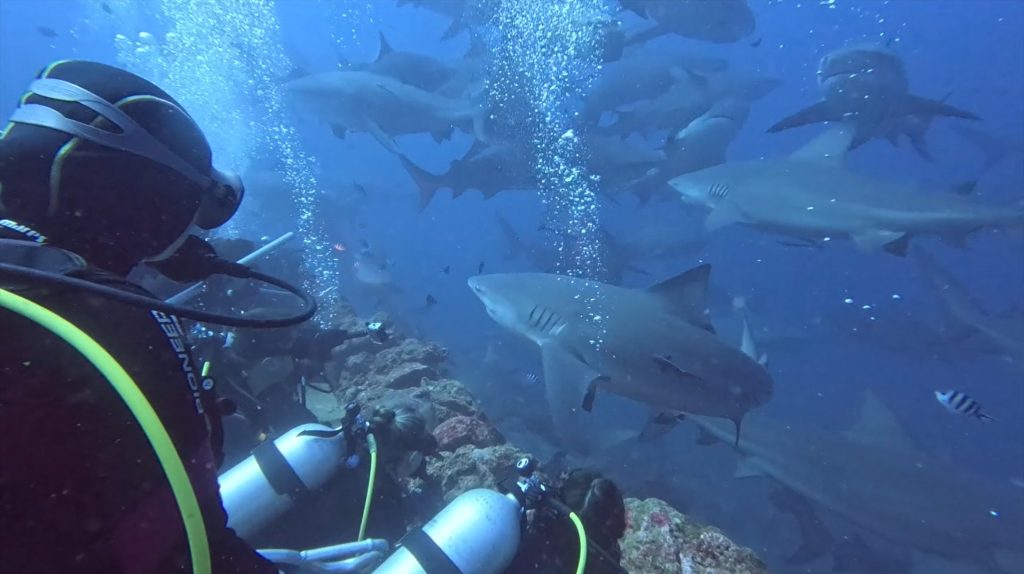
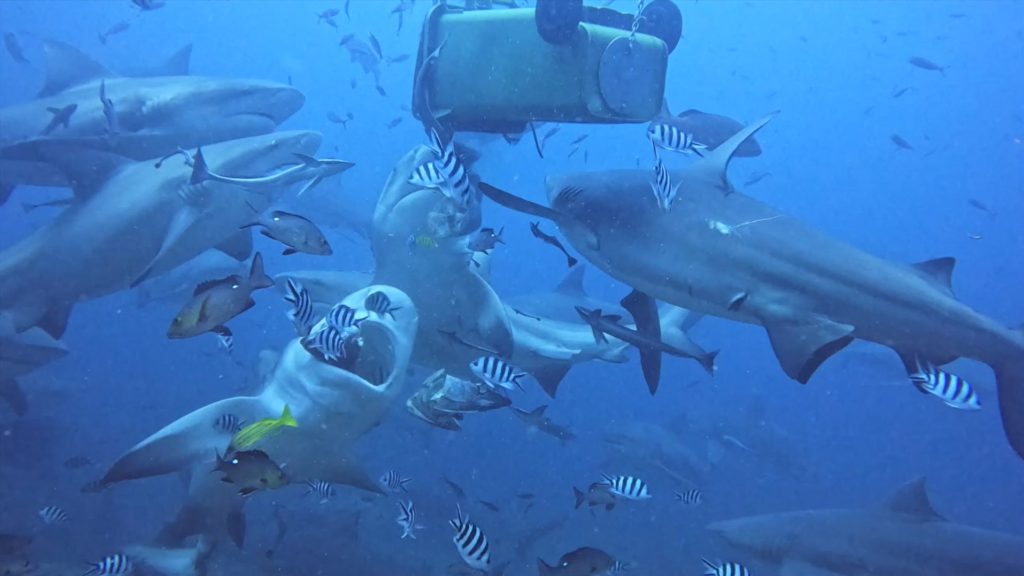
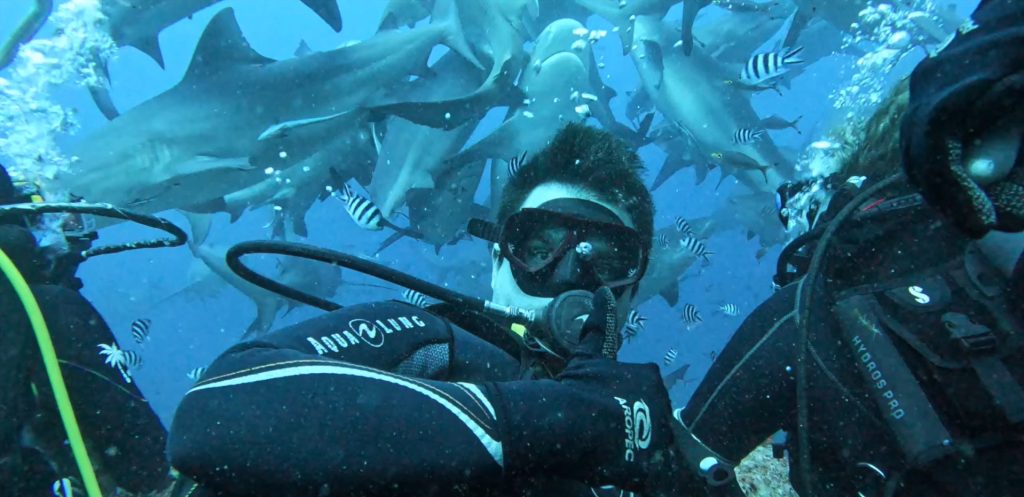
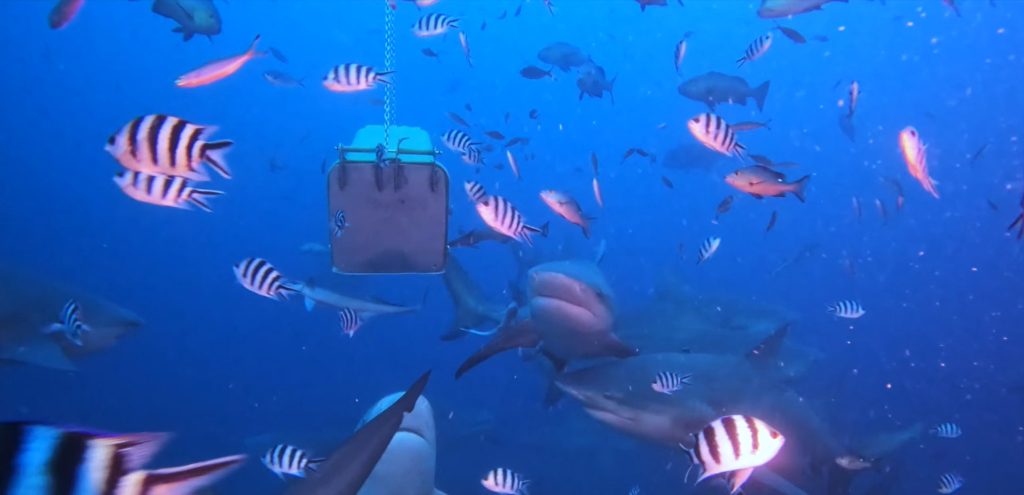
Did I say inches? Not even that far. As the wheelie bin got closer or a tuna head floated in our direction, the shiver came down upon us. Getting grazed across the mask by a pectoral fin or getting slapped in the head by their tales was a common occurrence. The Bull Sharks don’t like to touch us, but they will if it means they can sneak in and get a feed. This was the highlight of the dive for me! How could you get closer than that? Literally coming into contact with them.

After about 20 minutes of feeding, we ascended up the coral wall and finished off the dive with 15 minutes of cruising past the most colourful part of the reef. All the while, sharks cruised around, out in the blue, leaving us alone and doing their thing. Sometimes, faint outlines of them were all you could see. In any other situation in your life, this would be terrifying, but after a couple dives, you knew what was down there, and nothing seemed too scary.

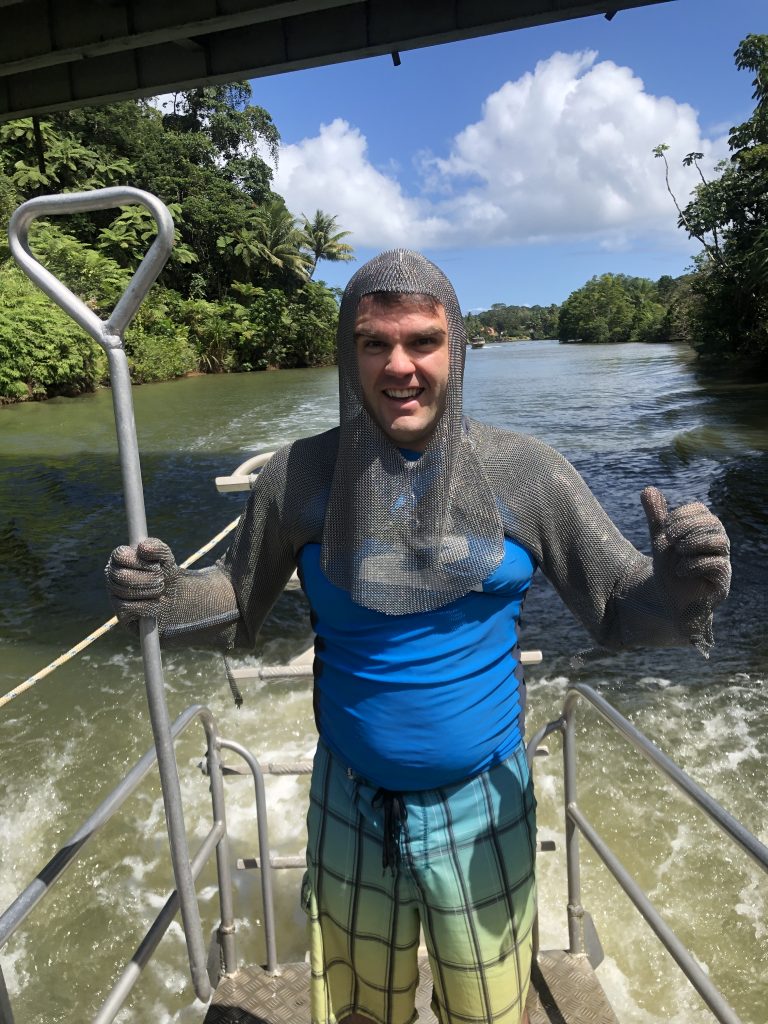
Final Thoughts
Before I end, I just want to touch on the conservation aspect of this operation. I have been criticised, in the past, for engaging in shark cage diving, because it programmes the sharks to associate humans with food. In the interest of learning, I lead with this question to several of the divemasters. What I learned is quite interesting and has helped me to form a deeper opinion of this operation.
For several decades, the local villagers have known that sharks existed in large numbers on this particular reef. They know this because in Fiji, specific reefs, or areas of coastlines, belong to specific villages, to watch over as guardians. Twenty years ago, extensive effort was made to lobby the government to protect this reef, which we know as Shark Reef, today.
In 2004, it was officially established as Shark Reef Marine Reserve. That means no fishing, no drag netting, and no snorkelling or scuba diving, except for Beqa Adventure Divers. They are the only operator allowed to moor and operate on this reef. And we divers pay a $25 FJD per day levy for the ability to partake in diving operations on the reef. To help control the marine reserve, a few of the divemasters are trained as fishing wardens, so they have the legal right to ask anyone to leave if they are doing an unpermitted activity within the marine reserve.
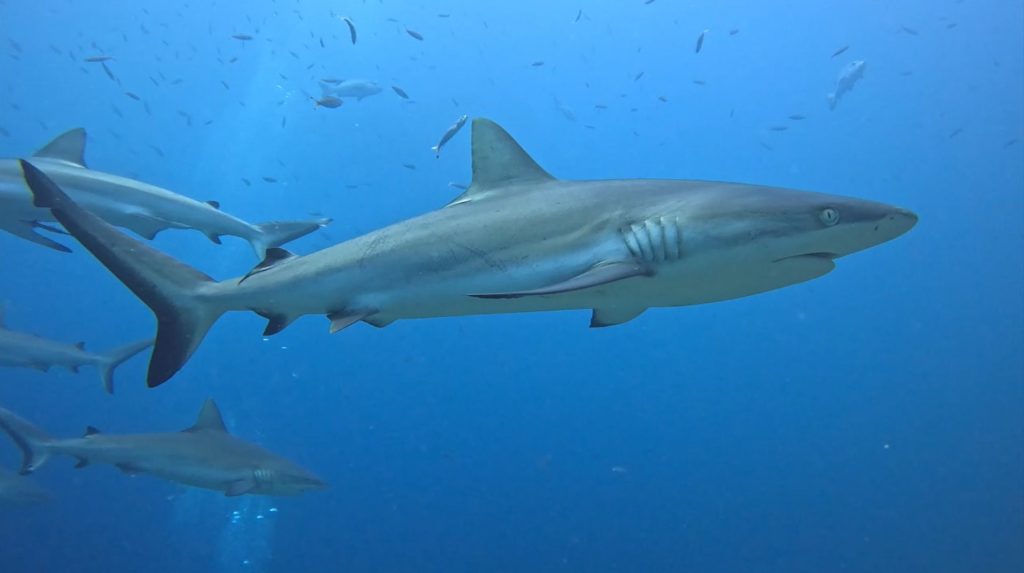
There are some obvious pros that come from this: First, protection for the sharks. Second, heavily regulated numbers of tourists interacting with the reef and the sharks. Third, the operation generates money that goes back into ongoing protection of the marine reserve and the sharks.
Here’s the darker side. Do the sharks know when it is feeding time? Yes. Do they know the sound of the boats? Yes. Have they been trained to recognise something at the end of a hand as food? Yes. Have we humans had an impact on these sharks, that could have been avoided? Yes. Has this drastically changed their lives and their ability to hunt and feed themselves? That one’s a no!
The conservation team worked with James Cook University in Brisbane to complete isotope testing on the tuna and the sharks to understand how much of this feeding contributed to their diet. The result was that it was a significantly small portion of their diet. It is how I described it many times: a snack. They are still out in the wild hunting, but they know when and where to get a free snack.
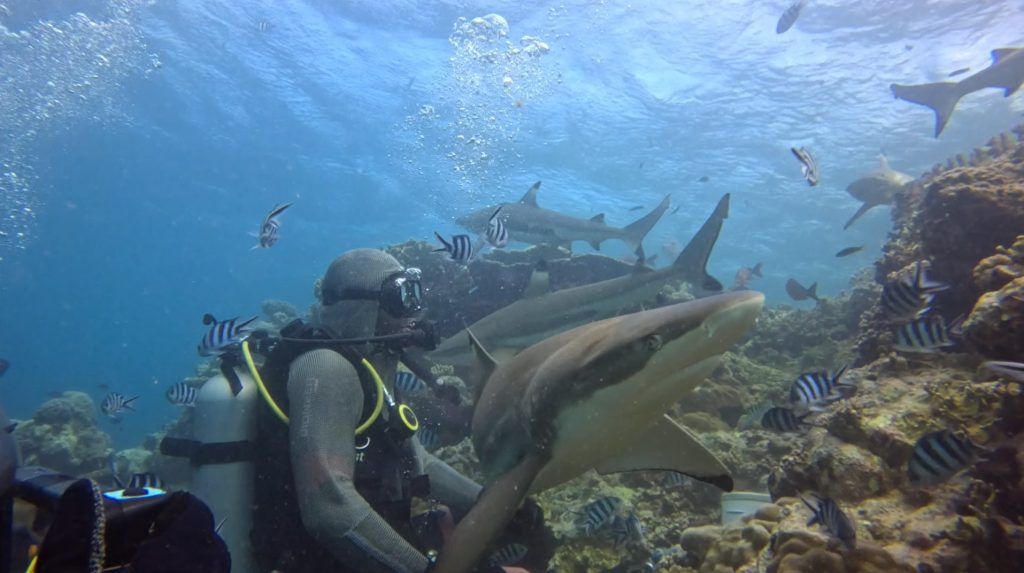
What I realised is that there is an intertwined relationship between humans, sharks and the marine reserve. One that I think is on the positive side. Without the tourism operation, there would not be enough money to uphold this marine reserve. From there, education about shark conservation, protection for the sharks and many other positive aspects begin to disappear. We cannot have one without the other.
So, my belief is that this is a good thing for the sharks and for us. I truly wish that this continues into the future, as this is an incredible place to interact with these amazing, and misunderstood, creatures!
Make sure to read my next post, [#88 Lesson] The Conundrum of Fear, which discusses the lesson learned by completing this item. Want to be notified when new blog posts are uploaded? Subscribe below.

Dave has been on a mission, since 2010, to cross off the 100 items on his bucket list. The stories of his adventures are complimented by life lessons learned along the way and his travel tips are unique to his experiences.

